December Observances
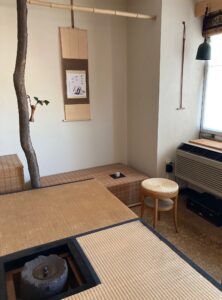
Ga-ran-dō, 伽蘭洞, Attend-orchid-cave; shiki-shi, 色紙, color-paper, paste-board, (see below) mounted as kake-jiku, 掛軸, hang-scroll. Hana, 花, flower, tsubaki, 椿, camellia, in a kake hana-ire, 掛花入, hang flower-receptacle, wooden bobbin. Kō-gō, 香合, incense-gather, porcelain covered box displayed on brown fabric ko-buku-sa, 古帛紗, old-cloth-gauze. In the ro, 炉, hearth is a ya-hasu-gama, 矢筈釜, arrow-nock-kettle.
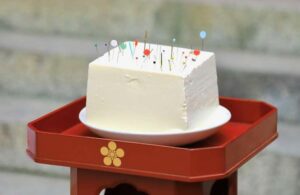
The theme of the Tea presentation features sewing and fabrics, and the Buddhist and Shintō rites of Hari ku-yō, 針供養, needle offer-nurture, memorial, which occurs on December 8th. The rites offer thanks to sewing needles for their efforts in making clothing and other fabric items. As part of the offering, the needles and pins that are old, bent, or broken and are easily inserted into blocks of tofu or konnyaku. Some temples and shrines observe the rites on February 8th, which is the time when ume no hana, 梅の花, prunus-flower’s, bloom, and the source of the design on the san-bō, 三方, three-directions, stand. The contrast is quite attractive between the red of the stand and the white tofu.
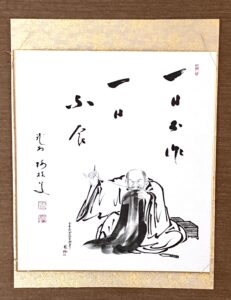
Shiki-shi, 色紙, color-paper, paste-board, with a printed drawing of a monk sewing his ke-sa, 袈裟, camlet-surplice. or black robe, and calligraphy, inset calligraphy, ‘ichi nichi fu-saku ichi nichi fu-shoku’, 一日不作 一日不食, one day no work one day no food, by Matsu-kura Shō-ei, 松倉紹英, Pine-storehouse Help-excel, (1908-1983) abbot of Ryō-an-ji, 龍安寺, Dragon-peace-temple, Kyōto.
The phrase originated by the celebrated Chinese priest, Bai-zhang Huai-hai (in Japan, Hyaku-jō Ei-kai), 百丈懐海, Hundred-(ten ‘feet’) Heart-sea, 749-814, China. Baizhang is the name of the mountain where his temple was located. In Buddhist training, an essential procedure is that one must sew together the patches of fabric with extreme discipline in creating one’s kesa. If a parallel is drawn in Chanoyu with the kesa, perhaps it would be the ko-buku-sa, 古帛紗, old-cloth-gauze.
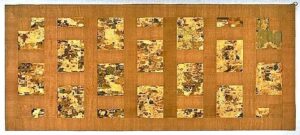
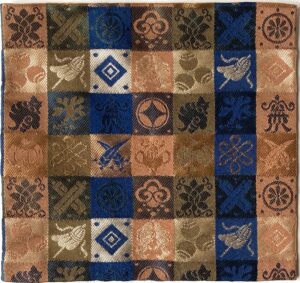
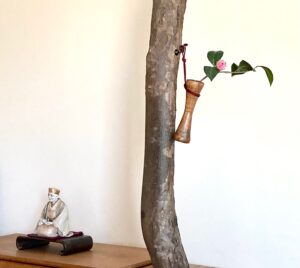
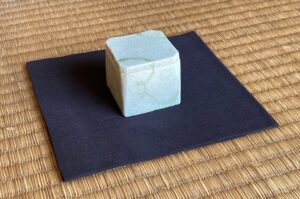
In Japan, December is referred to as Jū-ni–gatsu, 十二月, Ten-two-month. Other observances held in December include the following:
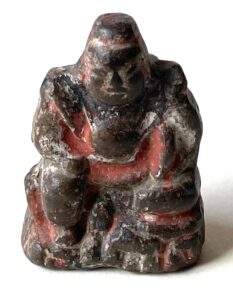
December 3 – Observance of the lunar E-bi-su-kō, 恵比寿講, Bless-like-longevity-association. Ebisu (many different Kanji are used for his name), was the first-born child of the primal couple Izanami and Izanagi. He is the god of fishermen, and is the only god of Japanese origin of the Shichi-fuku-jin, 七福神, Seven-fortune-gods. He is often depicted with Dai-koku, 大黒, Great-black, the god of rice, who is another of the Seven Fortune Gods.
December 5 – Osame no Sui-ten-gū, 納の水天宮, End’s Water-heaven-palace, time to settle arrangements with the god, Sui-ten, 水天, Water-heaven (Deva). A yearly event that finalizes obligations. Originally, Suiten, Hindu god Varuna/Varna was a deity second only to Indra, who rules over water, and protects the five great dragons that reside in the sea. Due to a confluence of words, Suiten became a deity who helps with the ease in childbirth.
December 7 – Tai-setsu, 大雪, Great-snow, one of the 24 seasonal divisions of the solar year, and start of the Ne no Tsuki, 子の月, Rat’s Month. The Buddhist protector of the zodiac sign of the Rat is Kan-non Bo-satsu, 観音菩薩, See-sound Grass-buddha, goddess of mercy. The rat is the vehicle of Ganesha. See December 22.
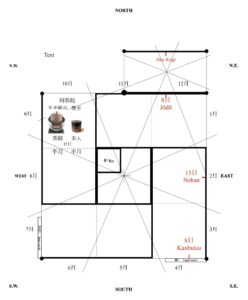
December 8 – Koto-osame, 事納め, Matters-end. Osame Yaku-shi, 納薬師, End Medicine-master. Jō-dō-e, 成道会, Attain-way-meet, the enlightenment of the Buddha. Last day of the eight days of strict Buddhist meditation called Rō-hatsu Se-sshin, 臘八接心, Offering-eight Contact-heart. The Kanji 臘is the offering ceremony according to the lunar calendar held on the third day of the Dog after the winter solstice, December 22.
December 9 – Daikoku’s Dai-koku, 大黒, Great-black, is a Hindu deity that is one of the Shichi-fuku-jin, and the god of rice. On this day some Japanese, especially in Niigata, celebrate O-toshi-ya, お歳夜, Hon.-year-eve, when Daikoku is offered a special dinner. There is a secret image of Daikoku at the Nichiren temple of Hon-pō-ji, 本法寺, Origin-law-temple, where part of Urasenke is located in Kyōto.
December 10 – Dai-tō-sai, 大湯祭, Great-hot water-festival, held annual at the Ō-miya Hira-kawa Jin-ja, 大宮氷川神社, Great-palace Ice-river God-shrine, in Saitama City. It is one of the oldest shrines in Japan, founded about 2,400 years ago. Urasenke presents Kencha, 献茶, Offering-tea on occasion, with other Tea gatherings. The Daitōsai is also a fire festival that began in the 14th century. Daikoku and Ebisu are enshrined here. During the festival of Tō-ka-ichi, 十日市, Ten-day-market, more than a thousand shops sell various talismans and foods, in preparation for the New Year.
December 22 – Ri-ttō, 立冬, Attain-winter; winter solstice, middle of the Ne no Tsuki, 子の月, Rat ’s Month. Yuzu-yu, 柚湯, citrus-hot water; yuzu, Citrus ichangensis x C. reticulata), fruits are put in the bath for soaking oneself to prevent sickness in the New Year.
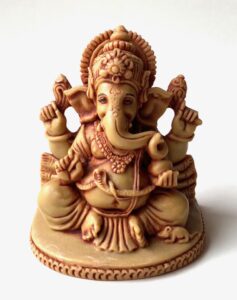
In India, Ganesha, the elephant-headed son of Shiva, is worshipped by Hindus in a five-day celebration called Pancha Ganapati, Five-face Ganesha, held from the winter solstice 21st to the 25th. Ganesha, a teacher of the Buddha, is renowned for removing obstacles. Ganesha in Japan is known as Kan-ki–ten, 歓喜天, Delight-joy-heaven(Deva), and Shō-ten, 聖天, Holy-heaven, (Deva).
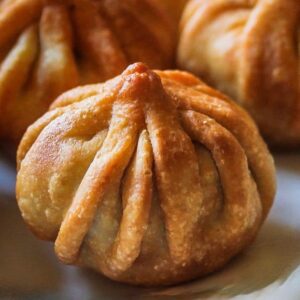
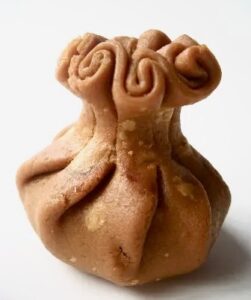
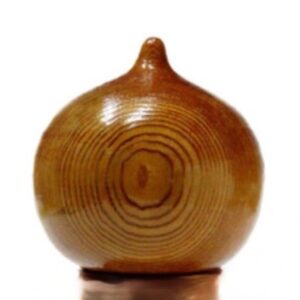
Ganesha/Kankiten loves sweets in Hindu called modaka, delight-joy, which are dumplings of grated coconut and other ingredients and jaggery sugar, wrapped in rice flour of wheat flour, like Chinese dim sum. The modaka is the inspiration for one of Japan’s greatest and earliest sweets, deep-fried, that are named after Ganesha/Kankiten, called kan-ki-dan, 歓喜団, Delight-joy-round. Among the many savory and sweet ingredients in the filling is yuzu. The modaka closely resembles the hō-ju, 宝珠, treasure-jewel, which is symbol of united water and fire, undifferentiated In and Yō, Yin and Yang.
December 28 – Monthly veneration of Sen no Rikyū. Osame no Fu-dō, 納めの不動, Settlement ’s No-move, last day of the year venerating the Buddhist deity who is the wrothful manifestation of Dai-nichi, 大日, Great-sun, who is the Buddhist universe made manifest.
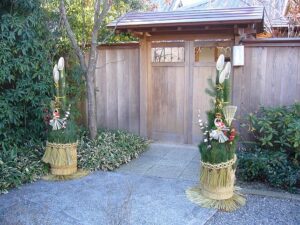
One of the important displays for the New Year in Japan is the ka-do-matsu, 門松, gate-pine. There are countless styles of kado-matsu but a familiar display is made of a pair (female and male) of three stalks of take, 竹, bamboo of different lengths, stood upright with matsu, 松, pine, boughs and branches of ume, 梅, prunus. Collectively, these are the three friends, shō chiku bai, 松竹梅, pine bamboo prunus.
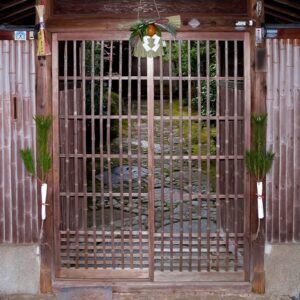
On or around December 29 to January 3, a pair of ka-do-matsu, 門松, gate-pine, are displayed on opposite sides of the front door of a home, temple, shrine, business, offices, etc. One of the ancient displays of the kadomatsu is a pair of pine saplings retaining their roots, are attached to the posts of a home’s gate, mon. Some mon posts have a permanent L-hook, kugi, 釘, hook, for this display.
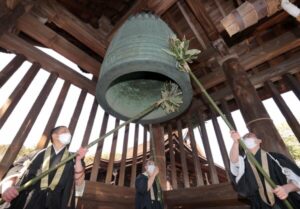
Buddhist priests cleaning the bon-shō, 梵鐘, temple-bell, of On-jō-.ji, 園城寺, Garden-palace-temple, also known as Mi-i-dera, 三井寺, Three-well-temple, in preparation for New Year’s Eve and the jo-ya-no-kane, 除夜の鐘, dispel-night’s bell. The priests of the temple are dusting the bell with a bunch of take no ha, 竹の葉, bamboo leaves, attached to the end of length of ao-dake, 青竹, green-bamboo. This is called susu-harai, 煤払い, soot-banish, and more spiritually, imi-dake, 忌竹, mourning-bamboo. Photo from Kyōto Shinbun. The bell in the below picture of Garandō is a souvenir from Miidera.
December 31 – New Year’s Eve. Jo-ya, 除夜, Exclude-night, New Year’s Eve. [Lunar New Year 2024 is February 10.] ]
Jo-ya gama, 除夜釜, Exclude-night kettle, last Tea of the year. Joy-ya no kane, 除夜の鐘, Exclude-night’s bell; temple bells are rung 108 times to dispel desires to which all humans are subject. The number 108 in Japanese is hyaku-hachi, 百八, hundred-eight, which is symbolic of many things; 108 divided by 6, symbolic of Infinity in Time, equals 18. The Japanese number for 18 is jū-hachi, 十八, ten-eight, which can be combined to create the Kanji moku, 木, tree, which is symbolic of ‘life’.

Iron kan-shō, 喚鐘, call-bell, modeled on a bon–shō, 梵鐘, buddhist-bell, from Mi-i–dera, 三井寺, Three-well-temple, Ō-tsu–shi, 大津市, Great-port-city, with a mulberry ki–zuchi, 木槌, wood-mallet, also called a shu–moku, 撞木, hammer-wood; L. 3 shaku kane-jaku. Both implements are hanging for practical usage, as well as symbolically descending from heaven. The Japanese word for ceiling in ten-jō, 天井, heaven-well.
In the Tearoom, the bonshō is represented by the kan-shō, 喚鐘, call-bell, which is rung at night to beckon guests from the naka-dachi, 中立 , middle-stand, in the ro-ji, 露地, dew-ground, garden, back into the Tearoom.

The Garandō kanshō is inscribed with the Kanji for Mi-i-dera, 三井寺, Three-well-temple, and features two dragon heads that form the lug from which it is hung. A purple silk cord can be used to carry the bell.
January 1 – Start of 2024 – Year of the Dragon. Ki-no-e Tatsu, 甲辰, Wood’s older-brother Dragon, these Kanji are also read Kō-Shin, 甲辰, Shell-Vibrate. The lunar New Year begins on February 10, 2024.
For further study, see also: Tea in December, Tea in Mid-December, and Sekimori Ishi and Ganesha

